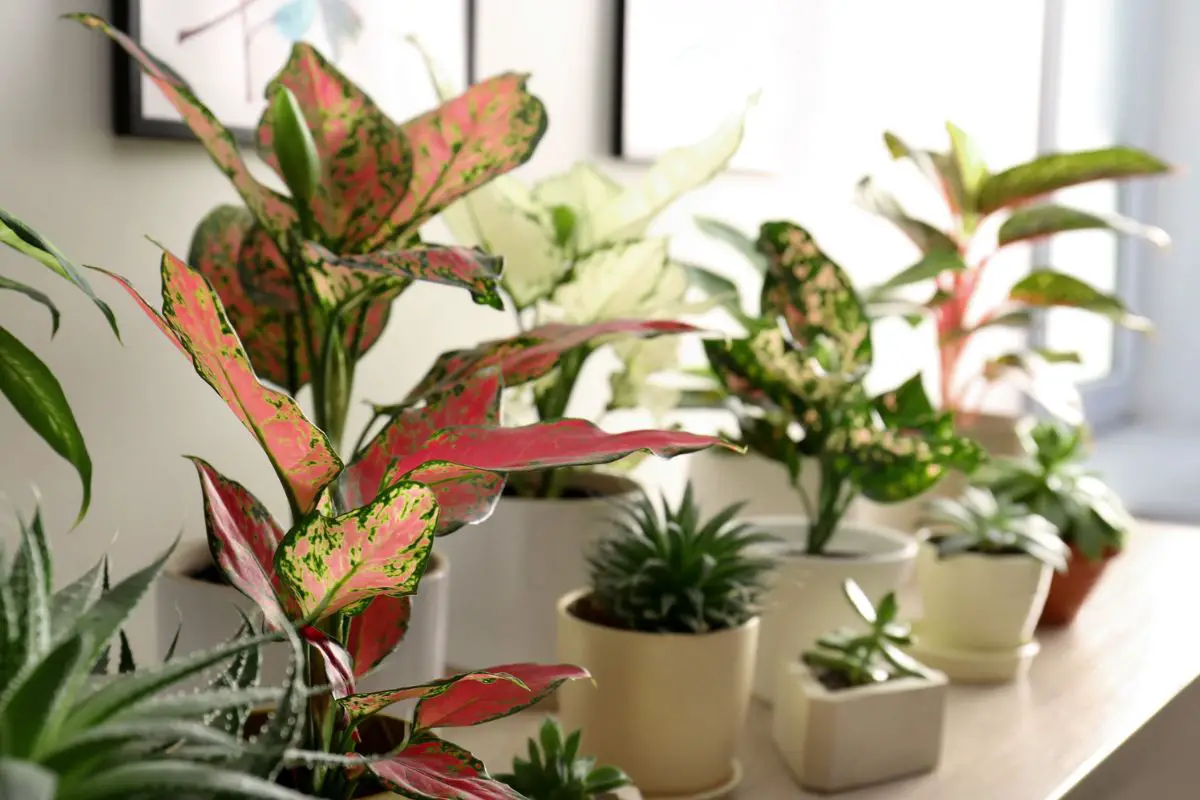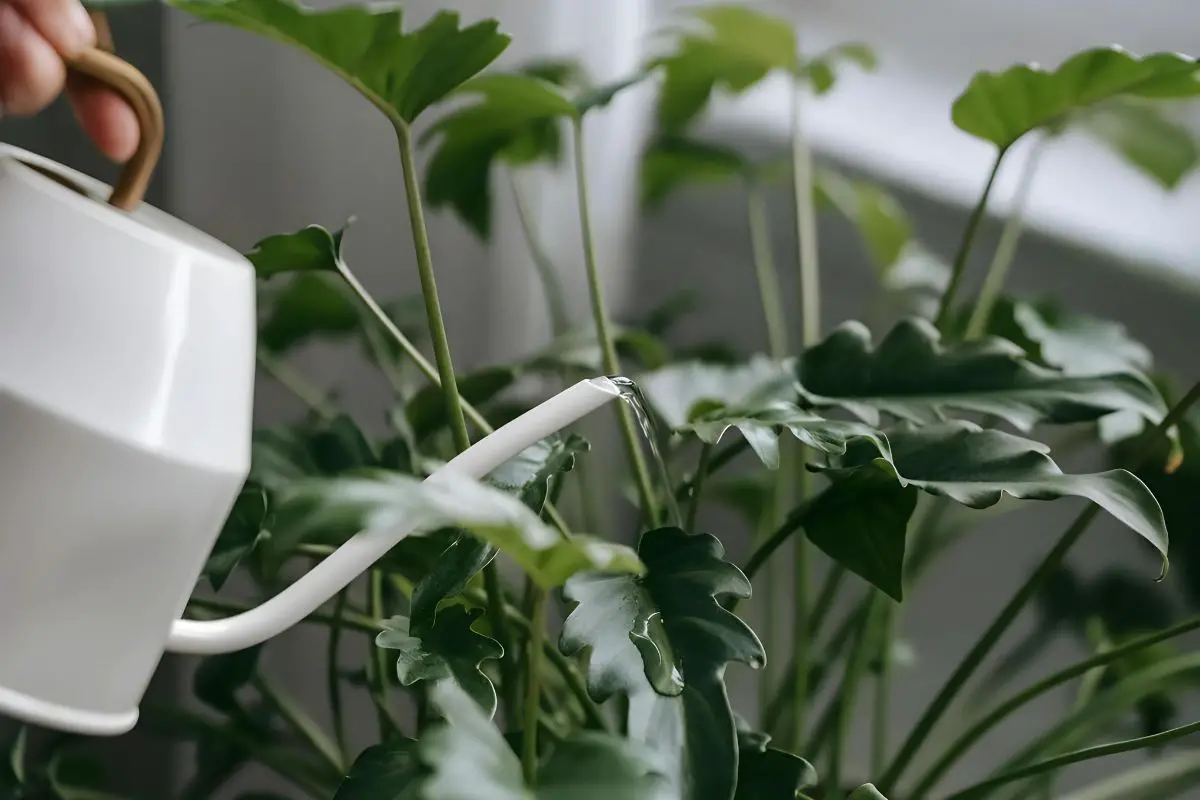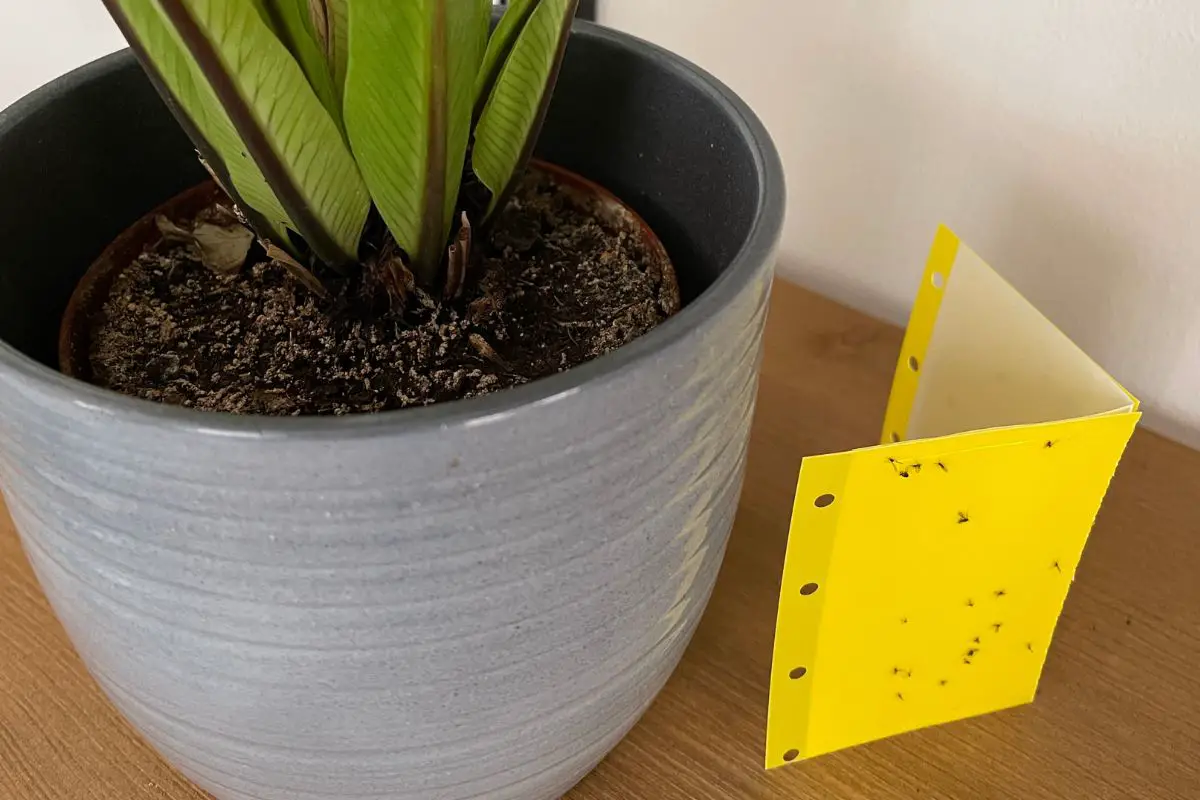Gnats are tiny insects that can pester you beyond belief. Unfortunately, even with the best care practices, you’ll likely run into a gnat infestation in your plants sooner or later. For when you do, it’s best to be prepared to take them out before they can multiply and spread to other plants.
Get rid of gnats in plants by making an insecticide mix with dish soap. Apply the mixture to gnat-infested plants using a spray bottle, place the liquid trap next to your plants, or drench your soil in dish soap solution. Keep up treatment until no gnats remain—this can take a few weekly sessions.
This article will be a comprehensive step-by-step guide on using dish soap and a few other common household items to deal with gnats. I’ll also tell you how to safeguard your plants against future gnat infestations.
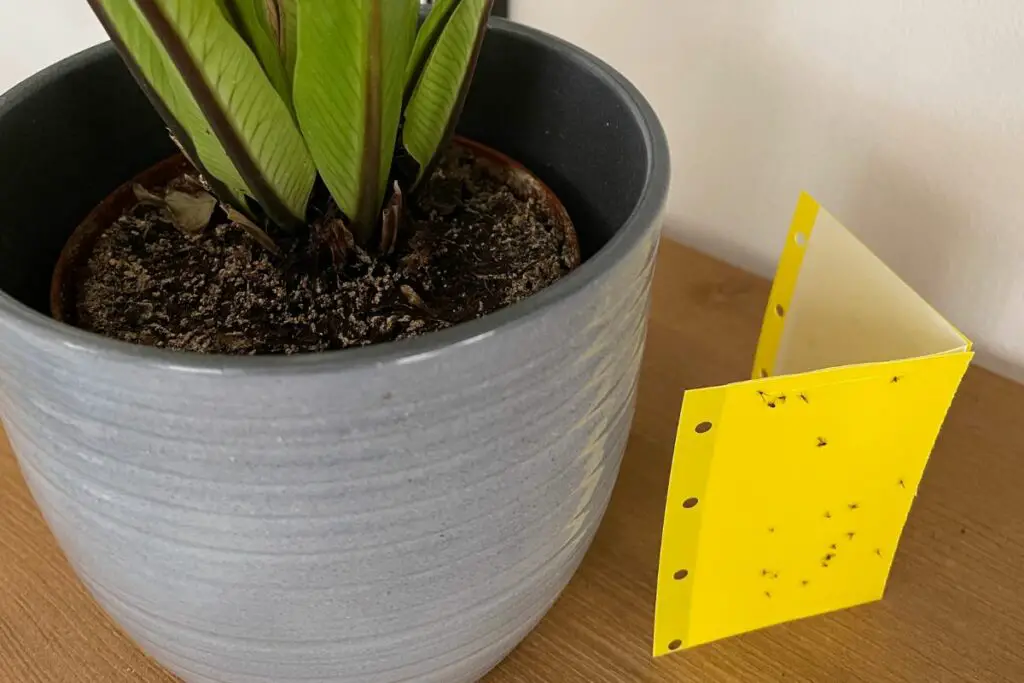
The Effects of Dish Soap Solution Against Gnats
Gnats or fungus gnats are insects that are attracted to the fungi in your potting soil. Healthy soils naturally have fungi but constantly moist or wet soil tends to have unhealthy populations of fungi that attract gnats.
Adult gnats will lay eggs in the soil, which will hatch into larvae. These larvae will then feed on the plant’s roots, causing severe damage in high enough populations.
Insecticide is your first line of defense when staving off an assault by all sorts of tiny bugs and critters. It’s readily available, effective, and does what it’s supposed to do quickly.
That said, it’s not the best idea to use full-strength, commercial-grade insecticide as soon as you get the chance. As great as it is at killing insects, it has the potential to cause serious damage to sensitive or vulnerable plants as well.
If your gnat infestation is still in its initial stages, you can deal with it without bringing out the heavy weaponry. Instead, go for options that are gentle on your plants, such as using a homemade insecticide made with dish soap.
There are three ways you can use the solution to get rid of gnats:
Liquid Lure Will Drown Them
The adult gnats will be lured into the liquid dish soap mix instead of your potting soil. The liquid will immobilize them and eventually kill them. This is a passive way of catching adult gnats flying near your plants.
The Spray Will Immobilize Individual Gnats
You can proactively attack flying gnats or those resting on the plant’s leaves using a dish soap spray. However, this method requires too much time and effort and is less effective.
You can also spray the soil directly because the eggs and pupae tend to dwell within the top 1-2 inches (2.5-5 cm) of the soil. However, larvae can go as deep as 3 inches (7.6 cm) or more. A small volume of liquid from spraying won’t be enough to reach and kill them.
A Soil Drench Will Kill and Flush Eggs and Larvae
This solution has the benefit of being super-convenient as well. Why run out to the store to buy expensive insecticides when you can simply make do with the ingredients you have at home?
I do need to stress, though, that you should not rely on the dish soap solution to treat large-scale infestations that span across multiple plants.
If an infestation gets that bad, you must use this method with other solutions to deal with gnat eggs and larvae in the potting soil. I discussed these solutions in more detail in my other article: 6 Ways to Deal With Fungus Gnats in Your Soil
How to Make Homemade Dish-Soap Insecticide
With that out of the way, let’s find out how we can make dish-soap insecticide at home.
1. Prepare Your Insecticide Mix
The items you’ll need are:
- Water
- Dish soap
- Vinegar
The amount of solution can vary depending on the type of treatment you intend to use.
Spray
- 1 cup (250 ml) of water
- 2-3 drops of dish soap
Liquid Trap
- 1 cup (250 ml) of water
- 1 tablespoon of dish soap
- 1 tablespoon of apple cider vinegar
Drench
- 1 gallon (3.8 l) of water
- 1 tablespoon dish soap
- 1 tablespoon white vinegar (5%)
If your plant needs more water, increase the amount of water and dish soap accordingly.
2. Spray Gnat Infested Plants
Now that your gnat-killing spray is ready, it’s time to test it. Yes, I did say that it won’t hurt your plants, but it’s better to see how your plants react to it before going all in. Better safe than sorry.
You should spray a leaf of a clean plant and wait for at least 24 hours before checking for results. If you don’t notice any bleaching, loss of color, wilt, or other signs of distress, you’re good to go.
If you do notice the above-mentioned distress signals, you may have added too much dish soap, or the target plant may have been particularly sensitive to the homemade insecticide.
Nevertheless, you can’t delay for too long, as a gnat infestation is best stomped early on. Gnats can multiply in population in mere weeks. Dilute the solution further by adding 1/2-1 cup (125-250 ml) of water.
Spray gnat-infested plants all over thoroughly. Make sure to get all the foliage, including the underbelly of the leaves—this is where most pests tend to hide.
Use a generous amount of spray mix. It’s okay if some of it seeps into the soil, as it won’t cause any toxicity due to the dilution.
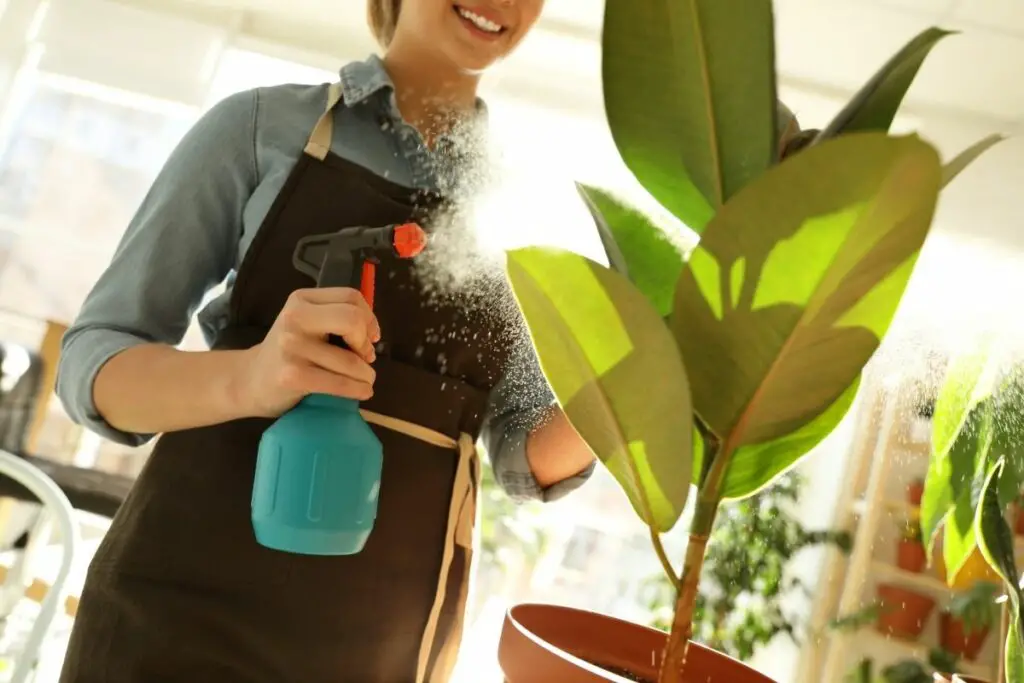
3. Repeat Weekly Until No Gnats Remain
The dish soap solution is only effective if it’s in direct contact with the gnats. It doesn’t have any residual effect on plant leaves because it’s been diluted. It’s also the same reason why it’s generally safe as a foliar spray.
Avoid making a more concentrated spray solution in an attempt to make the treatment more effective. A concentrated solution will break down the leaf’s waxy coating, causing damage to the plant.
However, it’s likely that there are survivors. Gnat larvae can reside deep in the soil to feed on the roots. A dilute spray like the one we just used likely won’t be able to kill off these larvae completely.
4. Add Soap to Your Regular Watering
Even if you get rid of the visible adult gnats with dish soap spray, you likely won’t be able to kill off the larvae. This is a major problem because unless you can kill the larvae hiding underneath the soil, the gnats will keep returning to bother you and your plants.
To attack the larvae in the soil directly, add dish soap to your regular watering using the formula recommended for a soil drench: 1 tablespoon dish soap and 1 tablespoon white vinegar for every gallon (3.8 l) of water.
You’ll need to be a bit more generous with the amount of the solution in this case because, unlike adult gnats, larvae are protected by the soil.
Water thoroughly until you see water exit from the bottom of the drainage hole.
Resume the treatment every other time you water your plant until you’ve gotten rid of the gnats. I would even recommend keeping it going for two sessions to guarantee the death of any remaining larvae.
Don’t get me wrong; our dish soap solution will work. It’s just less effective and will take longer to get rid of the larvae.
5. Complement Your Efforts With a Gnat Trap
It’s time to get creative and engage in some DIY. We can construct a specialized gnat trap to lure the unsuspecting critters to their sudden demise!
This isn’t a substitute for the regular spray routine I’ve detailed above. However, it is a great addition. A gnat trap will allow you to catch and kill any stray adult gnats wandering around your house. It’s great for keeping your indoors gnat-free while you’re handling an infestation.
Here’s how to build this trap:
- Get an empty bowl. Any similar container will also work.
- Pour in a cup (250 ml) of water.
- Add a tablespoon of apple cider vinegar to the bowl.
- Add 1 tablespoon of liquid dish soap.
Although optional, you can add a teaspoon of sugar to the mixture for better results.
You can be flexible with the quantity of apple cider vinegar and dish soap you add to the bowl. The only thing to keep in mind is to add both liquids in equal parts.
The apple cider vinegar has a sweet, fruity smell irresistible to gnats. Nearby gnats will be lured into the mixture, only to be trapped inside by the sticky, dense dish soap we’ve added. The trapped gnats will be unable to escape and will drown in the mixture.
You can use red wine as an alternative to apple cider vinegar and it will do the job just as well. The sugar increases the attractiveness of the trap, and while it’s not necessary, it does help.
You can also cover the setup with clear plastic and poke some holes through it. The gnats will enter the holes and won’t be able to leave.
In the end, we get a compact, portable gnat trap that you can place near gnat-infested plants to cull their population. One trap per plant should be enough. You can make multiple traps to deal with infestations spread across multiple plants.
Often, when you spot gnats on your plants, you’ll spot them in other hotspots around your house as well. Kitchens, for example, are places where gnats tend to congregate to feed on leftovers and scraps. You should place one of these traps in your kitchen as well.
Once the trap catches enough gnats, you can dispose of everything inside the bowl into a garbage bag and prepare a new mixture if necessary. You can expect to have to do this once every couple of days.
6. Soak the Entire Plant in Soapy Water
I only advise doing this in extreme cases, like when you can’t get a handle on the infestation despite your best efforts.
Soaking the entire plant, pot included, in water will cause the gnats infesting it to drown. Now, you can use only water for this because it will work to get the adult gnats off your plant’s foliage.
However, water with dish soap has the additional benefit of killing off gnats in the soil. You can make soapy water by diluting a tablespoon of dish soap in one gallon (3.8 l) of water.
Completely submerging your pot in soapy water for 5-10 minutes should be enough to saturate the soil and wet the leaves.
You should not submerge your plant in water if it’s in a container with no drainage hole. Doing so will almost certainly lead to overwatering, which can be devastating.
After you’ve completely soaked your plant in water with dish soap, leave it on a drip tray until all the excess water has finished flowing out of the drainage holes.
7. Water Your Plants Less to Prevent Future Infestations
The lack of a drainage hole might be the underlying problem causing or at least contributing to your gnat problem. Plants grown in containers that don’t have drainage holes are easily overwatered. Any water in excess stays in the soil with no way to escape (other than naturally, through evaporation).
Overwatered soils are conducive to fungal growth. This soil-based fungus then attracts fungus gnats.
Fungus gnats are named so because their larvae feed on fungi in the soil. Therefore, they typically only inhabit soils that have fungus growing in them, mostly due to overwatering.
Not only does overwatering lead to gnat infestations, but it also has several direct, severely damaging consequences for the affected plant.
The most notable is root rot. As you may already know, plant roots need oxygen to survive and function normally. When there’s too much water in the soil, their access to oxygen is cut off, and they begin suffocating.
The oxygen-deprived roots die, leaving behind a plant incapable of fending for itself. If enough roots die, the plant eventually succumbs to starvation.
It may sound scary. Unfortunately, it is. Overwatering is the leading cause of death in indoor houseplants. We tend to overestimate how much water most plants need grossly, so it’s something important to consider.
Here’s how to avoid overwatering your plants:
Water Less Frequently
With most houseplants, you should aim to let the soil or growing medium dry out a bit between waterings. This is a great way to stave off overwatering. Letting the soil dry out guarantees that your plant roots aren’t always standing in water.
Go With Deep Waterings
Watering the soil deeply, all the way through, is much better than simply wetting the top layer. Thorough watering encourages plants to grow their roots deeper into the soil. You can also bottom water your plants to keep the soil surface from becoming wet.
Use Pots With Drainage Holes
Simply put, not using a pot with drainage holes is just asking for trouble. You can still use pots without drainage holes as cachepots to fulfill your decorative desires.
Use a Well-Draining Potting Mix
You can increase the water-draining ability of your soil by mixing in organic matter, such as compost. However, I don’t recommend doing this until you’ve properly handled the gnat infestation. Gnats feed on decomposing organic matter in the soil, so they will feed on the compost and multiply.
Move the Plant to a Room With Lower Humidity
You may also want to move gnat-infested plants to a less humid environment for the time being. Most plants prefer high humidity, but unfortunately, so do gnats. By lowering the humidity, you can make environmental conditions unfavorable for pests.
However, avoid moving your plant to a very dry room that can compromise its health. If your plant thrives in 30-50% humidity, you can move it to a room that has 30% humidity but never lower.
8. Clean the Affected Plant Regularly
This is just a solid plant-care guideline in general. Whether you’re an avid outdoor gardener or someone who values houseplants for their decorative capacity, you should regularly inspect and clean your plants.
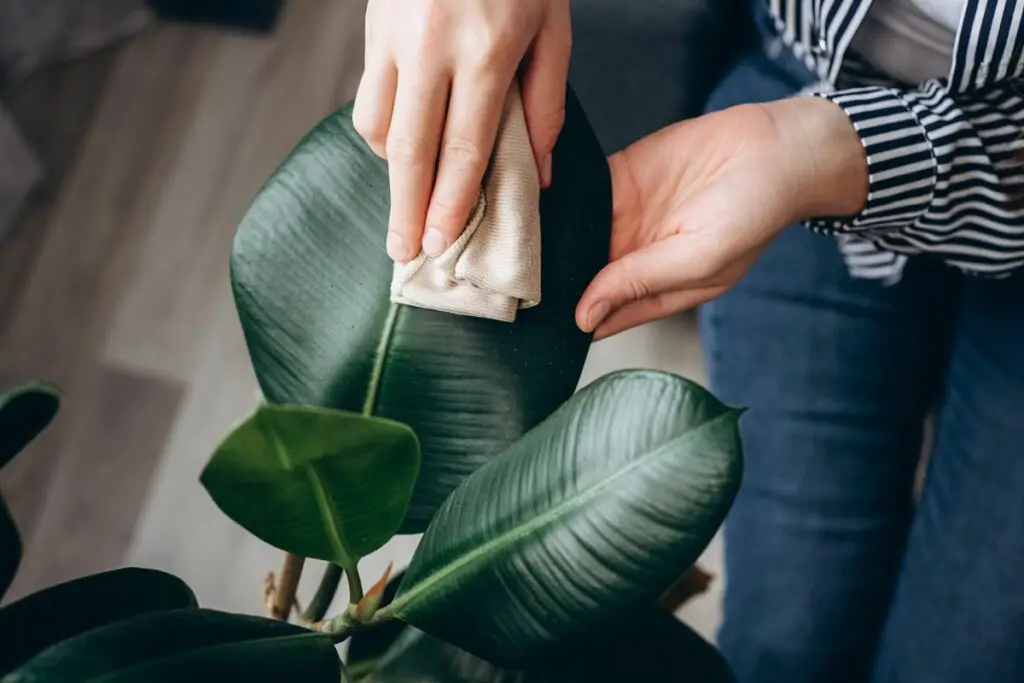
Doing so will help keep your collection free from pests, insects, and diseases. A clean plant is also better able to absorb sunlight and oxygen, although the difference is marginal.
You can clean your plants with a standard spray bottle and cloth. Make sure to get all the foliage. Leaf undersides are hiding spots for pests, so they’re worth paying special attention to.
Remove any decomposing organic matter above the soil as it attracts gnats.
Plant cleaning doesn’t have to be another chore on your list. You can do it once or twice monthly and it will still provide great benefits.
9. Check for and Eliminate Items That May Be Attracting Gnats
By now, we’ve taken several steps to deal with the gnat infestation head-on with dish-soap-based insecticide. We’ve also discussed how we can make environmental conditions unfavorable for these bugs by adjusting water, humidity, and hygiene.
Now, let’s tackle the problem at its root cause and get rid of the things that may be attracting gnats to your home. This will help prevent the gnats from returning in the future.
Here are the items you want to identify and eliminate from your surroundings:
- Leftovers and food scraps, especially fruits
- Uncovered garbage containers
- Spills of sweet liquids, such as honey
- Dirty drains
- Stagnant water
- Decomposing organic matter (mulch and compost are usually fine, but you should refrain from applying either during an infestation)
10. Seek Professional Help if Necessary
If the infestation becomes widespread and takes over multiple plants, you may want to seek professional help.
The problem is that gnats multiply rapidly. Larger infestations are exponentially harder to deal with. Your best bet to stop one is to act in its early stages and prevent it from ever establishing a foothold on one of your plants, where it can easily spread to the rest.
Final Thoughts
To get rid of gnats in plants using dish soap:
- Spray the affected areas with dish-soap-based insecticide.
- Add dish soap and vinegar to each watering to kill the larvae.
- Build a gnat trap to catch and eliminate stragglers.
- Soak the entire plant in water with dish soap, if necessary.
- Let the soil surface dry out between waterings.
- Check up on and clean your houseplants regularly.
- Eliminate any gnat-attracting items.
- If all else fails, seek professional help.
That about sums up our guide. I hope you learned something useful and wish you all the best in dealing with your gnat problem.
If you would like to explore more options to get rid of gnats in your soil, check out my other article: How to Deal With Fungus Gnats in Your Soil

